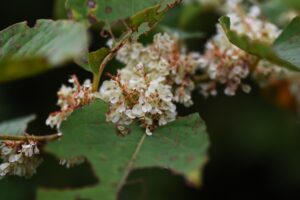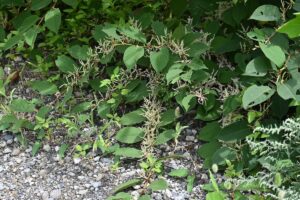What to Look For In a Knotweed Removal Business: A Comprehensive Guide
Knotweed, also known as Japanese Knotweed, is a highly invasive plant that can wreak havoc in your garden or landscape if left unchecked. Its rapid growth and resilience make it a formidable opponent for any homeowner or gardener. That’s why when it comes to tackling this invasive plant, seeking professional help is often the best course of action. However, not all Knotweed removal businesses are created equal. To ensure you get the job done right, knowing what to look for in a Knotweed removal company is crucial.
In this comprehensive guide, we will look into the various methods and strategies for removing knotweed, as well as the essential factors to consider when choosing the right professionals and learn how to cope with knotweed. Let’s find out now!

Understanding Knotweed
Knotweed, often referred to as “Japanese knotweed,” is notorious for its aggressive growth patterns and the damage it can cause to buildings and infrastructure. It’s crucial to understand the characteristics of knotweed to effectively combat it. Here are some key points to keep in mind:
Identifying Knotweed
Knotweed has distinct features, including bamboo-like stems, heart-shaped leaves, and small, clustered white or greenish flowers. Identifying these characteristics is the first step in managing its growth.
Why Knotweed Is a Problem
Knotweed can damage foundations, disrupt drainage systems, and even impact property values. Its ability to spread rapidly makes early intervention essential.
The Impact on Native Plants
Knotweed can outcompete native plant species, leading to a loss of biodiversity in your garden or landscape.
What to Look For In a Knotweed Removal Business
When seeking professional assistance to remove knotweed, it’s crucial to choose a reputable and experienced knotweed removal business. Here are the factors to consider:
1. Experience and Expertise
The first and most critical factor when selecting a Knotweed removal business is their experience and expertise in dealing with this tenacious plant. Knotweed is not your typical garden weed; it’s a formidable adversary that requires in-depth knowledge for effective eradication.
Look for a company with a proven track record in successfully managing Knotweed infestations. Experienced professionals understand the plant’s biology, growth patterns, and control methods, which are essential for a successful removal process.
2. Proper Licensing and Certification
A reputable Knotweed removal business should have the licenses and certifications to operate legally and safely. These credentials indicate that the company meets industry standards and follows recommended best practices. Certifications from recognized industry bodies or government agencies are a good sign that the business is qualified to handle Knotweed removal.
3. Comprehensive Inspection and Assessment
Before any removal work begins, a reliable Knotweed removal business will thoroughly inspect and assess the infested area. This step is crucial to determine the extent of the infestation and the most appropriate removal strategy. Beware of companies that provide quotes without first inspecting the site, as they may not accurately assess the scope of the problem. A comprehensive assessment ensures the removal plan is tailored to your Knotweed infestation.
4. Tailored Removal Plan
Knotweed infestations can vary widely in terms of size, location, and severity. A one-size-fits-all approach is rarely effective. A reputable removal company will develop a tailored removal plan based on the specific characteristics of your infestation. This plan should outline the treatment methods to be used, the timeline for removal, and the expected outcomes. A personalized approach is crucial for successful Knotweed eradication.
5. Safe and Eco-Friendly Practices
Environmentally responsible Knotweed removal is essential to minimize the impact on local ecosystems. Ask potential removal companies about their approach to environmental sustainability. Reputable firms will use safe and eco-friendly practices, such as targeted herbicide application and proper disposal of contaminated materials. They should be well-versed in minimizing collateral damage to surrounding vegetation and wildlife.
6. Clear Pricing and Transparency
Transparent pricing is a hallmark of a trustworthy Knotweed removal business. You should receive a detailed breakdown of costs, including inspection fees, treatment costs, and any charges for follow-up visits. Avoid companies that provide vague or unclear pricing structures. Transparency ensures that you understand what you’re paying for and helps you avoid unexpected expenses.
7. References and Reviews
A reliable Knotweed removal business should be happy to provide references from past clients or direct you to online reviews and testimonials. Hearing about the experiences of others who have used their services can provide valuable insights into the company’s reliability, professionalism, and effectiveness of Knotweed removal services. Don’t hesitate to reach out to references for their input.
8. Guarantees and Warranties
A reputable Knotweed removal business should stand by the quality of their work. Inquire about any guarantees or warranties they offer. This demonstrates their commitment to ensuring that Knotweed does not return after removal. A solid guarantee provides peace of mind and shows that the company takes its responsibility seriously.
9. Insurance Coverage
Accidents can happen during Knotweed removal operations, and you’ll want to ensure that you’re protected. Verify that the removal company carries appropriate insurance coverage to cover any potential damages or liabilities that may arise during the removal process. Insurance coverage is a vital safeguard for both the removal company and property owners.
10. Local Knowledge
Local knowledge of the area and its specific Knotweed challenges can be a significant advantage. A removal company familiar with the local environment is better equipped to address the unique characteristics of Knotweed infestations in your region. They may also have insights into the best practices for managing Knotweed in your specific location, which can lead to more effective removal strategies.

How to Remove Knotweed DIY
Removing knotweed requires a systematic approach, as it can regrow from small fragments of its roots or stems. Here are the steps to effectively remove knotweed from your property:
Step 1: Survey and Assessment
Conduct a thorough survey to identify the extent of the knotweed infestation. Assess the areas affected and create a plan for removal.
Step 2: Safety Precautions
Safety should be a priority when dealing with Knotweed. Wear protective clothing, including gloves and goggles, to avoid skin irritation. Additionally, use caution when handling chemicals, if needed, in the removal process.
Step 3: Herbicide Treatment
Herbicides are often used to control knotweed. Consult with a professional to select the right herbicide and follow application guidelines carefully.
Step 4: Manual Removal Methods
Cutting and digging out knotweed can be effective, but it’s essential to dispose of the plant material properly to prevent regrowth.
Digging and Excavation
One of the most effective manual methods for removing Knotweed is digging and excavation. Use a sharp shovel to dig up the rhizomes (underground stems) of the plant. Be thorough in removing as much of the root system as possible.
Cutting and Mowing
Regularly cutting or mowing Knotweed can weaken it over time. However, this method requires persistence, as Knotweed is resilient and may take several seasons to eradicate fully.
Covering and Smothering
Covering Knotweed with heavy plastic or mulch can deprive it of sunlight and hinder its growth. This method works best for smaller infestations.
Step 5: Monitoring and Maintenance to Prevent Future Infestations
Once you’ve successfully removed Knotweed, take preventive measures to avoid future infestations. Regularly inspect your property and maintain a healthy garden to deter its return.
Frequently Asked Questions (FAQs)
Can I remove knotweed on my own?
Yes, you can attempt to remove knotweed on your own, but it can be challenging. Hiring professionals is often more effective, especially for extensive infestations.
How long does it take to completely remove knotweed?
The time required to eradicate knotweed can vary depending on the size of the infestation and the chosen removal method. It may take several years of consistent effort.
Are there eco-friendly ways to remove knotweed?
Yes, some eco-friendly methods, such as using hot water or steam, can be employed for knotweed removal. Consult with a professional for guidance.
Is knotweed removal expensive?
The cost of knotweed removal can vary widely based on factors like the size of the infestation and the chosen removal method. It’s essential to obtain multiple quotes for an accurate estimate.
Can knotweed damage my property?
Yes, knotweed can damage buildings, disrupt drainage systems, and affect property values if left untreated.
What happens if knotweed is not removed?
Allowing knotweed to go unchecked can result in its spread, making removal more difficult and costly in the long run.
Conclusion
In conclusion, knowing how to remove knotweed and what to look for in a knotweed removal business is essential for safeguarding your home property. By following the steps outlined in this guide and considering the factors mentioned, you can effectively combat this invasive plant. Remember that when faced with a Knotweed infestation, seeking professional help from a reputable knotweed removal business is often the best solution. By carefully considering factors such as experience, licensing, tailored plans, eco-friendly practices, transparency, references, guarantees, insurance, and local knowledge, you can make an informed choice to cope with Knotweed effectively. Remember, the right removal company can make all the difference in ensuring a Knotweed-free future for your property, preserving its value, and protecting the local ecosystem.
